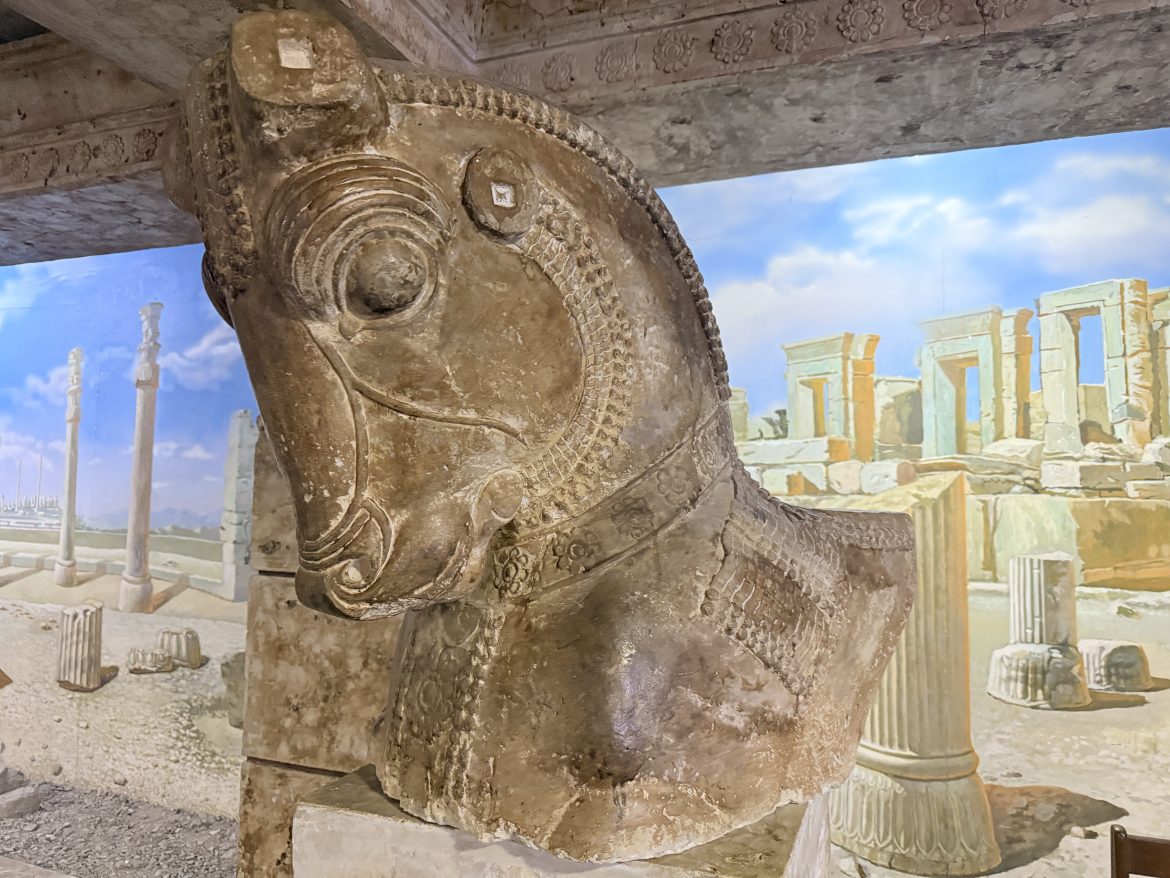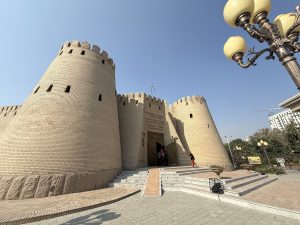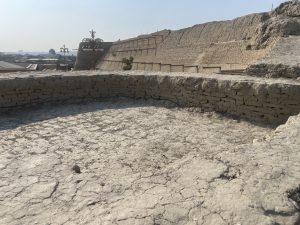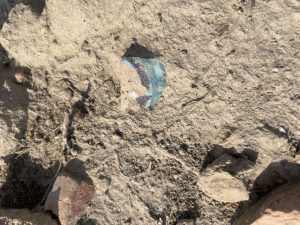During our visit to Tajikistan, one of the cities we explored was Khujand, located in the northwestern part of the country. We chose this destination for its rich historical significance. Khujand is one of the oldest cities in Central Asia, situated along both banks of the Syr Darya River, at the gateway to the fertile and densely populated Fergana Valley.
The Syr Darya, the longest river in Central Asia, flows through the Sughd region, enriching the fertile lands around Khujand. This area, often referred to as the “Pearl of Central Asia,” owes its reputation to its favorable geographical location and mild climate. The region’s natural abundance has long made it a hub of agriculture, trade and culture. Khujand, along with Samarkand, Merv, and Bukhara, was known for its unique Tajik culture and served as a major economic hub; it remains a vibrant city.
Historically, Khujand was a key stop along the Silk Road, the ancient trade route connecting China and Europe. Its strategic location attracted a diverse array of settlers and invaders over the ages. The city’s origins date back to the Achaemenid Empire, And at that time, the ancient Greeks and Romans knew of this city and saw it as an important border in Asia. In 329 BC, Alexander the Great established a military outpost here during his expedition to conquer the world, naming it Alexandria Eschate (“Alexandria the Furthest”). According to the historian Arrian, Alexander fortified the city, and remnants of those ancient walls were unearthed in recent archaeological discoveries.
Later, it was taken by the Arabs in the 8th century, who called it “Bride of the World”, Genghis Khan’s forces in the 13th century, and then by the Russians in 1866. Each era contributed to the city’s layered and fascinating history.
Before the Soviet era, the city still kept its oriental vibe. There were 146 mahallas—neighborhoods united by 33 Friday and 121 mahalla mosques. Over 100 houses (water pools), 300 teahouses (chaykhana). The city was famous for silk and other crafts. It produces outstanding scientists, poets, and musicians. According to the St Petersburg Gazette 1868, Khujand was surrounded by beautiful gardens of fruit trees, and the fruit grew in abundance and was sent to the surrounding areas.
We stayed in Khujand for three days. The main city attractions include:
The heart of Khujand’s commerce is the famous Panchshambe Bazaar, one of Central Asia’s largest covered markets. Its name, which means Thursday in Tajik, reflects the main trading day in the past, as Friday was traditionally a religious holiday.
Just steps from the market is the Sheikh Muslihiddin Mausoleum and Complex, a key historical and spiritual site. This complex includes a mausoleum, the Masjidi Jami mosque, and a minaret, although we could not enter the mosque because it was closed for renovations as of October 2025.
Other highlights include Kamoli Khujandi Park, a central and pleasant urban space on the banks of the Syr Darya River. It features a mausoleum and statue dedicated to the 14th-century poet Kamoli Khujandi. Nearby, the Syr Darya River Promenade offers an attractive walkway with nice views.
The most important historical site, however, is the Khujand Fortress. While much of the original structure was destroyed and subsequently rebuilt, it now houses the Historical Museum of Sughd, which showcases the region’s history from ancient times to the present day.
Getting there: We took a taxi to the fortress.
The ancient city of Khujand, like many medieval Islamic settlements in Central Asia, was organized into three distinct components: the Citadel (or Ark), the Shahristan, and the Rabat. The Citadel was the smallest but most fortified part, serving as the seat of the ruler and housing military and administrative functions, with the Khujand Fortress itself acting as the core workshop and residence of the rulers. Surrounding this was the Shahristan, the walled inner city where most of the population lived and where the main religious and communal buildings were located. The Rabat constituted the outer suburbs, which were typically less protected and developed later to accommodate commercial, industrial, and residential expansion.
Historical Significance and Origin
Its origins are traced back to the 6th-7th century BC (an archaeological claim noted in the original text), when it was initially built as a simple earth embankment that later developed into thick clay walls. The foundation is sometimes linked to Cyrus the Great (as part of Cyropolis) and later to Alexander the Great, who conquered the city in 329 BC. Symbol of Resilience: Throughout its history, the fortress was repeatedly destroyed by conquerors, only to be rebuilt.
Tripartite City Structure
The core of the settlement was the Citadel, or Ark-i-Kamil (the workshop of the rulers), which served as the seat of political and military power. The Khujand Citadel was a massive fortification:
It had a rectangular shape, covering 8 hectares, and was enclosed by a tall, fortified wall with many strong towers. The fortress structure was two-storied, featuring an iron gate (Ajan) on the eastern wall and the Shahristan gate on the southern part.
Later History and Destruction
The Khujand Fortress was a crucial strategic site throughout the centuries. According to historical accounts, including those of Zahiruddin Babur (a Mughal emperor and Timurid descendant), the fortress was reconstructed repeatedly between the late 11th and early 13th centuries.
However, its strategic importance made it a frequent target. It was first destroyed by Genghis Khan’s army in 1220 and later repeatedly damaged in the 18th and 19th centuries due to frequent invasions by troops from both the Bukhara Emirate and the Kokand Khanate. Eventually, the fortress became the site of a battle involving the joint forces of the Tsarist army. Following this conflict, its northern and southern walls and the ark-i-fortification (citadel) were placed under state protection in 1866.
Current State
Today, the existing structure is a reconstruction (primarily carried out from 1999) of the original fortress, featuring thick walls and gates. This complex now houses the Historical Museum of Sughd (Local Lore, Archaeology, and Fortification). The museum complex incorporates a restored section of the eastern wall, which dates to the 8th–10th centuries, and also features artisan workshops showcasing traditional crafts.
The walls and main gates have been rebuilt and restored. While the walls and gates are traces of the ancient fortifications, they, along with most of the buildings in the complex, are new constructions that aim to recreate the historical atmosphere of the ancient fortress and citadel.
Look for the Unrestored Mounds (The Remains) and Eastern Wall Section
To see the original scale and material, you should walk along the exterior or perimeter of the complex where the walls transition into the surrounding park/embankment.
Look for the actual clay-made mounts or earthworks; these are the foundations and archaeological layers of the ancient fortifications. You will have to climb on top of this area to get a good view of the size of the original citadel. Look for the remaining archaeological layers and the foundations of the first walls, which were made from a thick wall of natural clay or mud bricks.
The Museum
There is a modest museum inside the fortress, where you will find several treasured historical artifacts, notably a rare Saka warrior helmet and an extensive collection of pottery from the Classical, Hellenistic, and Medieval periods. A significant part of the exhibition is dedicated to the study of Khujand’s history and the work history of its archaeologists.



